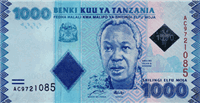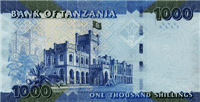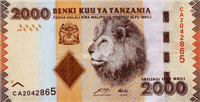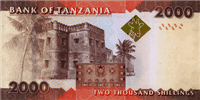Exchange Currency
Tanzanian shilling
The shilingi is the currency of Tanzania, although widespread use of U.S. dollars is accepted. It is subdivided into 100 senti (cents in English). The Tanzanian shilling replaced the East African shilling on 14 June 1966 at par.
Hordes discovered on the island of Pemba Tanzania show that Islamic coins of the Abbasid caliphs of Baghdad were imported in the ninth and tenth centuries. Locally made copper and silver coins were made during the eleventh century and have been found on Pemba and Zanzibar and in the city of Kilwa. Chinese coins and Egyptian gold coins have also been found.
German colonists began penetrating Tanzania in 1885. Germany obtained a lease over the coastal part of Tanganyika from the Sultan of Zanzibar on April 28, 1888. Zanzibar was ceded to Great Britain in 1890 in exchange for Heligoland. Tanganyika became the German protectorate of German East Africa in 1891. The British occupied Tanganyika in 1916 and received a League of Nations mandate over the territory on July 20, 1922. Tanganyika became a United Nations Trust territory in 1946. Tanganyika gained its independence on December 6, 1961, became the United Republic of Tanganyika and Zanzibar on April 27, 1964, and the United Republic of Tanzania on October 29, 1964.
The Portuguese arrived in Zanzibar in the 1400s, but by 1650, their influence had waned and the Omani Arabs conquered Zanzibar in 1698. Zanzibar separated from Oman on April 6, 1861 through British mediation. Zanzibar was proclaimed a British protectorate on November 7, 1890, and the coastal domains of Zanzibar and Pemba became part of the Kenya protectorate in 1895. The British protectorate over Zanzibar was terminated on December 10, 1963, the Peoples Republic of Zanzibar was declared on January 12, 1964, and Zanzibar united with Tanganyika on April 27, 1964. The sultan of Zanzibar issued his own coins in 1882.
Trade with India in the 1800s led to the introduction of Indian Rupees in Tanganyika. The German East Africa Company received the authority to issue Rupee banknotes and coins (DOAR) in 1890, which were issued at par to the Indian Rupee. The Rupee was divided into 16 Annas or 64 Pesa until 1906 when the Rupee was made divisible into 100 Cents. Kenyan and Indian Rupees were used between 1916 and 1920. Indian coins circulated in Uganda until their importation was made illegal on July 31, 1920.
The East African Currency Board of Nairobi was established to provide a medium of exchange for British East Africa (Kenya, Tanzania and Uganda). The British East African Rupee (XEAR) replaced the German East African Rupee in 1918 at par with the German East Africa Rupie. On July 31, 1920, the Florin (XEAF) replaced the Rupee, equal to two British Pound Shillings or one Indian Rupee and divisible into 100 Cents. On June 8, 1921, the East African Shilling (XEAS), equal to half a East African Florin and one British Shilling Sterling, and also divisible into 100 Cents, replaced the East Africa Florin.
The East African Shilling continued to be used both before and after Tanganyika united with Zanzibar to create Tanzania. On September 14, 1967 Tanzania introduced the Tanzanian Shillings (TZS) at par with the East African Shilling, and divisible into 100 Senti. The Shilling is issued by the Benki Kuu Ya Tanzania (Bank of Tanzania). The notes of Kenya, Uganda and Tanzania could be exchange without restriction in the commercial banks of other countries until 1971 when Uganda suspended the convertibility of notes.
Portuguese money was used in Zanzibar until the Arabs expelled the Portuguese in 1698. Zanzibar Ryals, equal to 2 Rupees, were issued in Zanzibar by the Arabs. Trade with India made the Indian Rupee the primary medium of exchange, and in 1908, after Zanzibar had been made a British protectorate, the Zanzibar Rupee, issued by the Zanzibar government and divisible into 100 Cents, was introduced. It traded at par with the Indian Rupee. The East African Shilling replaced the Rupee on January 1, 1936, and the Rupee ceased to be legal tender on April 6, 1936. The East African Shilling continued to be used both before and after Tanganyika united with Zanzibar to create Tanzania. On September 14, 1967 Tanzania introduced the Tanzanian Shillings (TZS) at par with the East African Shilling, and divisible into 100 Senti.
In 1987, nickel-clad steel replaced cupro-nickel in the 50 senti and 1 shilingi, and cupro-nickel 5 and 10 shillings coins were introduced, with the 5 shillings octagonal in shape. In 1990, nickel-clad-steel 5, 10 and 20 shillings were introduced, followed by brass coins for 100 shilingi in 1994, 50 shillings in 1996 and 200 shillings in 1998. Coins currently in circulation are the 50, 100 and 200 shillings.
Banknotes in circulation today are 500, 1000, 2000, 5000 and 10,000 shilingi.
Summary info
Summary information about Tanzanian shilling- ISO 4217 Code:
- TZS
- Currency sign:
- x/y
- Country:
- Tanzania
- Subunit:
- senti
- Coins:
- 50 shillings, 100 shillings, 200 shillings
- Banknotes:
- 500 shillings, 1000 shillings, 2000 shillings, 5000 shillings, 10000 shillings
- Central bank:
- Bank of Tanzania
History
The United Republic of Tanzania includes Tanganyika and Zanzibar.Hordes discovered on the island of Pemba Tanzania show that Islamic coins of the Abbasid caliphs of Baghdad were imported in the ninth and tenth centuries. Locally made copper and silver coins were made during the eleventh century and have been found on Pemba and Zanzibar and in the city of Kilwa. Chinese coins and Egyptian gold coins have also been found.
German colonists began penetrating Tanzania in 1885. Germany obtained a lease over the coastal part of Tanganyika from the Sultan of Zanzibar on April 28, 1888. Zanzibar was ceded to Great Britain in 1890 in exchange for Heligoland. Tanganyika became the German protectorate of German East Africa in 1891. The British occupied Tanganyika in 1916 and received a League of Nations mandate over the territory on July 20, 1922. Tanganyika became a United Nations Trust territory in 1946. Tanganyika gained its independence on December 6, 1961, became the United Republic of Tanganyika and Zanzibar on April 27, 1964, and the United Republic of Tanzania on October 29, 1964.
The Portuguese arrived in Zanzibar in the 1400s, but by 1650, their influence had waned and the Omani Arabs conquered Zanzibar in 1698. Zanzibar separated from Oman on April 6, 1861 through British mediation. Zanzibar was proclaimed a British protectorate on November 7, 1890, and the coastal domains of Zanzibar and Pemba became part of the Kenya protectorate in 1895. The British protectorate over Zanzibar was terminated on December 10, 1963, the Peoples Republic of Zanzibar was declared on January 12, 1964, and Zanzibar united with Tanganyika on April 27, 1964. The sultan of Zanzibar issued his own coins in 1882.
Trade with India in the 1800s led to the introduction of Indian Rupees in Tanganyika. The German East Africa Company received the authority to issue Rupee banknotes and coins (DOAR) in 1890, which were issued at par to the Indian Rupee. The Rupee was divided into 16 Annas or 64 Pesa until 1906 when the Rupee was made divisible into 100 Cents. Kenyan and Indian Rupees were used between 1916 and 1920. Indian coins circulated in Uganda until their importation was made illegal on July 31, 1920.
The East African Currency Board of Nairobi was established to provide a medium of exchange for British East Africa (Kenya, Tanzania and Uganda). The British East African Rupee (XEAR) replaced the German East African Rupee in 1918 at par with the German East Africa Rupie. On July 31, 1920, the Florin (XEAF) replaced the Rupee, equal to two British Pound Shillings or one Indian Rupee and divisible into 100 Cents. On June 8, 1921, the East African Shilling (XEAS), equal to half a East African Florin and one British Shilling Sterling, and also divisible into 100 Cents, replaced the East Africa Florin.
The East African Shilling continued to be used both before and after Tanganyika united with Zanzibar to create Tanzania. On September 14, 1967 Tanzania introduced the Tanzanian Shillings (TZS) at par with the East African Shilling, and divisible into 100 Senti. The Shilling is issued by the Benki Kuu Ya Tanzania (Bank of Tanzania). The notes of Kenya, Uganda and Tanzania could be exchange without restriction in the commercial banks of other countries until 1971 when Uganda suspended the convertibility of notes.
Portuguese money was used in Zanzibar until the Arabs expelled the Portuguese in 1698. Zanzibar Ryals, equal to 2 Rupees, were issued in Zanzibar by the Arabs. Trade with India made the Indian Rupee the primary medium of exchange, and in 1908, after Zanzibar had been made a British protectorate, the Zanzibar Rupee, issued by the Zanzibar government and divisible into 100 Cents, was introduced. It traded at par with the Indian Rupee. The East African Shilling replaced the Rupee on January 1, 1936, and the Rupee ceased to be legal tender on April 6, 1936. The East African Shilling continued to be used both before and after Tanganyika united with Zanzibar to create Tanzania. On September 14, 1967 Tanzania introduced the Tanzanian Shillings (TZS) at par with the East African Shilling, and divisible into 100 Senti.
Coins
In 1966, coins were introduced in denominations of 5, 20 and 50 senti and 1 shilingi, with the 5 senti struck in bronze, the 20 senti in nickel-brass and the 50 senti and 1 shilingi in cupro-nickel. Cupro-nickel 5 shillings coins were introduced in 1972, followed by scalloped, nickel-brass 10 senti in 1977. This First Series coins set, in circulation from 1966 up to 1984, was designed by Christopher Ironside OBE.In 1987, nickel-clad steel replaced cupro-nickel in the 50 senti and 1 shilingi, and cupro-nickel 5 and 10 shillings coins were introduced, with the 5 shillings octagonal in shape. In 1990, nickel-clad-steel 5, 10 and 20 shillings were introduced, followed by brass coins for 100 shilingi in 1994, 50 shillings in 1996 and 200 shillings in 1998. Coins currently in circulation are the 50, 100 and 200 shillings.
Banknotes
On 14 June 1966, the Benki Kuu Ya Tanzania (Bank of Tanzania) introduced notes for 5, 10, 20 and 100 shilingi (also denominated in shillings on the first series of notes). The 5 shillings note was replaced by a coin in 1972. 50 shillings notes were introduced in 1985, followed by 200 shillings in 1986, 500 shillings in 1989 and 1000 shilingi in 1990. The 10, 20, 50 and 100 shilingi notes were replaced by coins in 1987, 1990, 1996 and 1994, respectively. 5000 and 10,000 shilingi notes were introduced in 1995, followed by 2000 shillings in 2003. A new series of notes came out in 2011. These new notes include many security features that prevent counterfeiting.Banknotes in circulation today are 500, 1000, 2000, 5000 and 10,000 shilingi.
TZS banknotes pictures gallery
| 500 Tanzanian Shillings | |
|---|---|
| Banknote of 500 Tanzanian Shillings has dimensions 120×60 mm and main colors are hunter green, rifle green, asparagus, olivine, dim gray, pale spring bud, moss green and light gray. The banknote of 500 Tanzanian shillings was issued on the 1 January 2011. | |
 Obverse side of the 500 Tanzanian Shillings is showing the portrait of First President of Zanzibar - Abeid Amani Karume (1905-1972) and the Coat of arms. |
 Reverse side of the 500 Tanzanian Shillings is showing the Snake (Aesculap Rod), Nkrumah Hall at the University of Dar es Salaam, more student graduation procession and Giraffe's head. |
| 1000 Tanzanian Shillings | |
|---|---|
| Banknote of 1000 Tanzanian Shillings has dimensions 125×65 mm and main colors are light slate pale aqua, glaucous, light moonstone blue, air force blue, ucla blue and xanadu. The banknote of 1000 Tanzanian shillings was issued on the 1 January 2011. | |
 Obverse side of the 1000 Tanzanian Shillings is showing the portrait of First President of Tanzania - Julius Kambarage Nyerere (1922-1999), the Coat of arms, Bismarck Rock and a natural granite formation in Lake Victoria, Mwanza. |
 Reverse side of the 1000 Tanzanian Shillings is showing the Coffee plant (Coffea), State House, Ocean Road, Dar es Salaam and Giraffe's head. |
| 2000 Tanzanian Shillings | |
|---|---|
| Banknote of 2000 Tanzanian Shillings has dimensions 130×66 mm and main colors are pale gold, fawn, caput mortuum, rose ebony, chamoisee, bole, persian orange and antique brass. The banknote of 2000 Tanzanian shillings was issued on the 1 January 2011. | |
 Obverse side of the 2000 Tanzanian Shillings is showing the Lion's head, African savanna and the Coat of arms. |
 Reverse side of the 2000 Tanzanian Shillings is showing the Old Fort (Ngome Kongwe; Arab Fort) in Stone Town, Zanzibar, Palm trees and Giraffe's head. |
| 5000 Tanzanian Shillings | |
|---|---|
| Banknote of 5000 Tanzanian Shillings has dimensions 135×67 mm and main colors are blue bell, mountbatten pink, manatee, wild blue yonder, pale silver, thistle, grullo, dark lavender and light slate gray. The banknote of 5000 Tanzanian shillings was issued on the 1 January 2011. | |
 Obverse side of the 5000 Tanzanian Shillings is showing the Head of a Black Rhinoceros (Diceros bicornis) and the Coat of arms. |
 Reverse side of the 5000 Tanzanian Shillings is showing the Gold leaching plant at the Geita Gold Mine, Rough and cut diamonds and Giraffe's head. |
| 10000 Tanzanian Shillings | |
|---|---|
| Banknote of 10000 Tanzanian Shillings has dimensions 140×68 mm and main colors are puce, desert sand, candy pink, antique brass, rose vale, pale carmine, ruddy pink and almond. The banknote of 10000 Tanzanian shillings was issued on the 1 January 2011. | |
 Obverse side of the 10000 Tanzanian Shillings is showing the Head of an African Elephant (Loxodonta), Elephants in African savanna and the Coat of arms. |
 Reverse side of the 10000 Tanzanian Shillings is showing Bank of Tanzania headquarters, twin towers on Mirambo Street in Dar es Salaam, Flowers and Giraffe's head. |
Useful links
- About Bank of Tanzania:
- Bank of Tanzania
- List of currencies:
- Currencies
- Security and design features of TZS banknotes:
- TZS banknotes
- TZS currency on Wikipedia:
- Tanzanian shilling
- Official Website of Bank of Tanzania:
- www.bot-tz.org
- Commemorative coins:
- Commemorative Coins